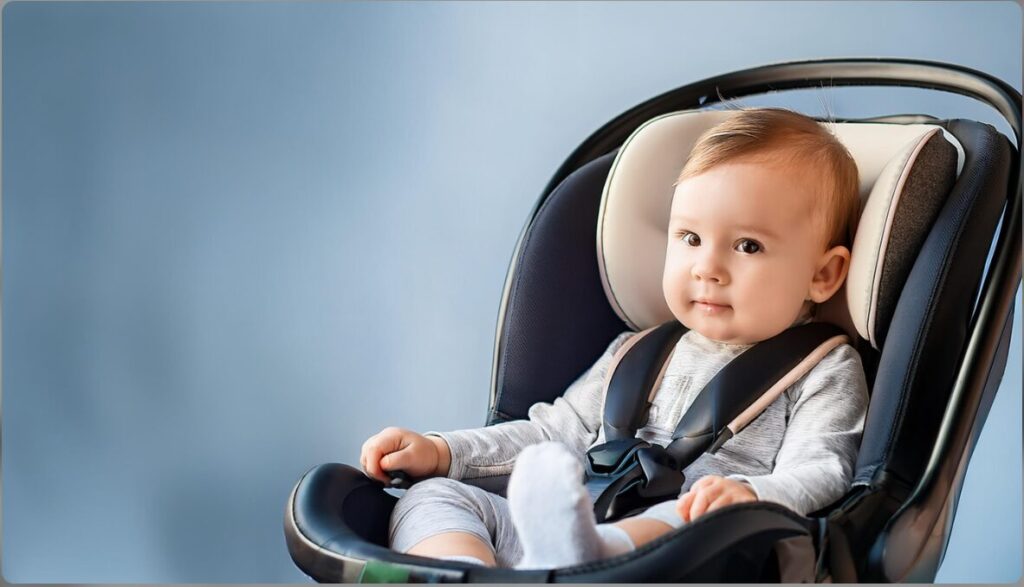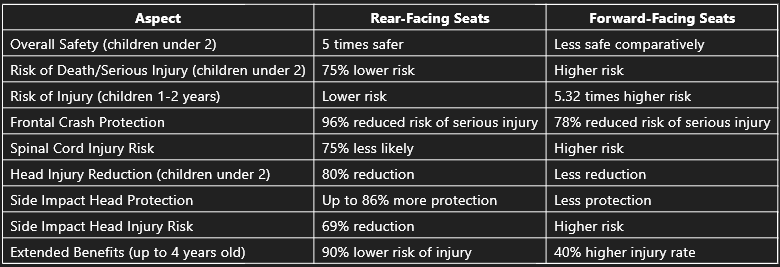Rear Facing vs Forward Facing

As a parent and certified child passenger safety technician (CPST), I’ve spent countless hours researching, installing, and advising on car seats. The question I get asked most often is: “When should I switch my child from a rear-facing to a forward-facing car seat?” It’s a crucial decision that can significantly impact your child’s safety, and I’m here to share everything I’ve learned through both professional training and personal experience.
The Short Answer: Keep Them Rear-Facing as Long as Possible If you’re looking for a quick takeaway, here it is: keep your child in a rear-facing car seat for as long as possible, ideally until they reach the highest weight or height limit allowed by their car seat manufacturer. For most children, this means staying rear-facing until at least age 2, but often until 3 or 4 years old.But I know you’re here for more than just a quick answer. Let’s dive deep into the world of car seat safety, exploring the pros and cons of rear-facing and forward-facing positions and why this decision matters so much.
Rear Facing vs Forward Facing
Rear Facing Car Seats
Let’s talk about rear-facing car seats—they’re super important for keeping your baby safe in the car! These special seats face the back of the car, and all babies start out riding this way. But why?Think of your baby’s body like a delicate flower. Their spine is still soft and growing, kind of like a bendy straw instead of a solid stick. That’s why they need extra care and support, especially in the car.Rear-facing seats are like a protective hug for your baby.
They support your little one’s whole body their head, neck, and back keeping everything safe and secure. This is really important because babies can’t hold their heads up on their own at first.Imagine if you had to stop the car suddenly. In a rear-facing seat, your baby would be gently pressed into the seat, spreading out any force across their whole body. It’s like being wrapped in a soft, protective shell!This is much safer than forward-facing seats for little ones.
In those, only the seatbelt would hold them, which could hurt their delicate bodies in a crash.Remember, every baby grows differently. While most kids use rear-facing seats until they’re about two years old, some might need them even longer. Always check with your doctor and follow what the car seat instructions say.By using a rear-facing car seat, you’re giving your precious little one the best protection possible when you’re on the road. It’s one of the most loving things you can do as a parent!
How Long Should a Child be Rear Facing
How Long Should Kids Sit Backwards in the Car?
When it comes to keeping your little ones safe in the car, you might wonder how long they should sit facing the back. Let’s break it down in a way that’s easy to understand.
What Does the Law Say?
First, it’s important to know what the rules are where you live. Each state has its own laws about car seats for kids.But remember, just because something is legal doesn’t always mean it’s the safest option.
Think about seatbelts in the back seat of a car. Some places don’t require adults to wear them in the back by law, but we all know it’s much safer if you do.Many states say children under two years old must sit rear-facing in their car seats
What Do the Experts Recommend?
Now, let’s look at what safety experts suggest. The big names in child safety—like the National Highway Traffic Safety Administration and the American Academy of Pediatrics—all agree on one thing: kids should face backwards in their car seats for as long as possible.
Why Backwards is Better
Sitting backwards might seem strange, but it’s actually much safer for young children. Here’s why:
- It protects their head, neck, and spine better in a crash.
- Young kids have big heads compared to their bodies, and their necks aren’t very strong yet.
- In a forward-facing seat, a crash could hurt their neck or spine badly.
So, How Long is “As Long as Possible”?
The exact time depends on your child’s size and their car seat’s limits. Most kids can stay rear-facing until they’re about 3 or 4 years old. Some car seats even allow rear-facing up to 50 pounds!
Weight Limit for Rear Facing Car Seat
As a parent who’s been through the car seat journey multiple times, I can tell you that understanding weight limits for rear-facing car seats is crucial. From my experience, most rear-facing car seats can accommodate children up to 40–50 pounds, but here’s the thing—it’s not just about weight.I remember when my eldest hit 30 pounds, and I thought, “Time to turn that seat around!” But my pediatrician quickly set me straight.
She explained that height is just as important as weight. Many kids can stay rear-facing well past their second birthday, even if they’ve reached 40 pounds.Now, every car seat is different, so always check your specific model’s guidelines. I’ve found that convertible car seats often have higher weight limits for rear-facing positions, sometimes up to 50 pounds.
This gives you more flexibility to keep your little one safer for longer.Remember, though, it’s not a race to face forward. In fact, the American Academy of Pediatrics recommends keeping kids rear-facing as long as possible, until they reach the highest weight or height allowed by their car seat manufacturer.
Trust me, those extra months or even years of rear-facing can make a world of difference in a crash.Always consult your car seat manual and your pediatrician for personalized advice. Every child grows differently, and safety should always be the priority. In my years of parenting, I’ve learned that when it comes to car seats, it’s better to play it safe.
Forward Facing Car Seats
Let’s talk about car seats that look toward the front of the car. These are called forward-facing car seats. They’re the next step after your child outgrows their rear-facing seat.Just like the seats that face backward, these seats use special straps that go over both shoulders, between the legs, and around the hips.
We call this a five-point harness. It’s designed to keep your child safe by spreading out the force if there’s an accident.However, there’s a big difference between forward-facing and rear-facing seats. In forward-facing seats, only the parts of your child’s body that touch the straps are really protected. This means their head isn’t as safe as it would be in a rear-facing seat.
If there’s a crash, there’s a higher chance of hurting the head, neck, or back. That’s why it’s super important not to switch to a forward-facing seat too early.But don’t worry! Forward-facing seats are still very safe when used at the right time. You should only move your child to a forward-facing seat when they’ve gotten too big for their rear-facing seat.
This typically happens when your child gets too big for the car seat. The seat’s manufacturer sets limits for how much weight it can hold and how tall a child can be while using it. Once your little one reaches either of these limits, it’s time for a change.Most kids stay in forward-facing seats with the five-point harness until they’re about 5 to 7 years old. It’s always best to keep your child in this type of seat for as long as possible, as long as they still fit within the seat’s size limits
.Remember, every child grows differently, so always check your car seat’s instructions and your local laws to know when it’s the right time to switch. Your child’s safety is the most important thing
Forward Facing Car Seat Requirements
If you’ve been using a rear-facing car seat for your child, you’re probably familiar with how to use it safely. But when it’s time to switch to a forward-facing seat, some things change. Let’s go through these changes together:
- Headrests Matter Now: Unlike with rear-facing seats, the car’s headrests become important for forward-facing seats. Make sure to read both your car’s manual and the car seat instructions to see how the headrests should be positioned.
- New Recline Angle: The safe recline angle changes when you switch to forward-facing. Most car seats have clear markers showing the right recline for each direction. If you’re not sure, check the manual—it’s your best friend for car seat info!
- Two Ways to Install: You can usually install forward-facing seats in two ways: using the car’s built-in anchors or the seat belt. But here’s something important: the anchors have a weight limit. Check your car seat manual for this limit and switch to using the seat belt once your child reaches that weight
- Don’t Forget the Tether: All forward-facing car seats in North America have a top tether—a strap that connects to a special anchor in your car. This is super important! It helps stop the seat from moving forward too much in a crash, which protects your child’s head. Many people forget about this because they didn’t use it with rear-facing seats.
- Strap Position Changes: In rear-facing seats, the straps had to be below your child’s shoulders. Now, they need to be just above the shoulders. Also, the buckle between the legs (called the crotch buckle) might need to be in a different spot now. Check your manual for the right position.
Remember, safety is still the top priority! Car seats work differently at each stage of your child’s growth. It’s a great idea to review your car seat manual every time you make a change in how you use it.
By understanding these changes and following the instructions carefully, you’ll make sure your child is safe and secure in their new forward-facing seat. Always double-check everything, and don’t hesitate to ask for help if you’re unsure. Your child’s safety is worth the extra effort!”
Why is Rear Facing Safer?
Rear-facing car seats are considered safer for young children for several important reasons:
- Head and neck protection: In a frontal collision (the most common type), a rear-facing seat cradles the child’s head, neck, and spine, distributing the force of impact across the entire back of the seat. This significantly reduces the risk of head and neck injuries.
- Reduced risk of internal injuries: rear-facing seats spread crash forces over a larger area of the body, reducing the risk of injuries to vital organs.
- Better support for developing bodies: Young children have proportionally larger heads and weaker neck muscles. Rear-facing seats provide better support for their developing skeletal structure.
- Protection in various crash types: While particularly effective in frontal collisions, rear-facing seats also offer enhanced protection in side impacts and rollover crashes.
- Alignment with crash dynamics: In a crash, occupants continue moving in the direction the vehicle was traveling. Rear-facing seats work with this motion rather than against it, reducing the strain on the child’s body.
- Extended period of protection: Modern rear-facing seats often fit children up to 40 pounds or more, allowing for extended use of this safer position.
Research consistently shows that children under two years old are up to five times safer in a rear-facing car seat compared to a forward-facing one. Many safety organizations recommend keeping children rear-facing for as long as possible, often until they reach the height or weight limit of their convertible car seat.
Remember, while rear-facing is generally safer, it’s crucial to follow the specific guidelines for your car seat model and ensure proper installation for maximum safety.
Rear facing vs forward facing crash test

Rear-Facing vs. Forward-Facing Crash Tests: Safety Implications for Children
When it comes to child safety in vehicles, crash tests consistently demonstrate that rear-facing car seats offer superior protection compared to forward-facing seats, especially for infants and young toddlers. Let’s examine the data and statistics that support this conclusion.
Effectiveness in Reducing Injuries:
A study published in the journal Injury Prevention found that rear-facing car seats are 5 times safer than forward-facing seats for children under 2 years old. Specifically:
- Children under 2 years old in rear-facing seats had a 75% lower risk of death or serious injury in crashes compared to those in forward-facing seats.
- For children aged 1-2 years, the risk of injury was 5.32 times higher in forward-facing seats compared to rear-facing seats.
Crash Test Results:
The National Highway Traffic Safety Administration (NHTSA) conducts extensive crash tests. Their findings show:
- In frontal crashes (the most common type), rear-facing seats reduced the risk of serious injury by 96% compared to unrestrained children.
- Forward-facing seats reduced the risk by 78%—still significant but not as effective as rear-facing seats.
Protection of Vital Body Parts:
A study by the Children’s Hospital of Philadelphia found that:
- Children in rear-facing seats were 75% less likely to sustain spinal cord injuries in crashes compared to those in forward-facing seats.
- For children under 2 years old, using rear-facing car seats instead of forward-facing ones lowered the risk of head injuries by 80%.
Real-World Data:
The American Academy of Pediatrics (AAP) analyzed real-world crash data and found:
- Children up to 23 months old in rear-facing seats were 75% less likely to die or be seriously injured in a crash compared to those in forward-facing seats.
- Even for children aged 12-23 months, rear-facing seats were 5 times safer than forward-facing seats.
Side Impact Protection:
In side-impact crash tests conducted by Consumer Reports:
- Rear-facing seats provided up to 86% more protection for a child’s head compared to forward-facing seats.
- When a car is hit from the side, babies in car seats facing the back of the car are about 70% less likely to hurt their heads compared to those in forward-facing seats.
Extended Rear-Facing Benefits:
A Swedish study, where children commonly remain rear-facing until age 4, found:
- Children in rear-facing seats had a 90% lower risk of injury compared to forward-facing seats, even for children up to 4 years old.
- The injury rate for forward-facing children was 40% higher than for rear-facing children in the same age group.
Rear facing vs forward facing pros and cons
Rear-facing Car Seats:
Pros:
- Better protection for the head, neck, and spine in frontal crashes
- Distributes crash forces more evenly across the back of the seat
- Recommended by safety experts for infants and young toddlers
- Provides better support for children who can’t sit upright independently
Cons:
- Limited legroom as the child grows
- More difficult for parents to see and interact with the child
- Some children may experience motion sickness
- Can be challenging to install correctly in some vehicles
Forward-facing Car Seats:
Pros:
- Allows for more legroom as children grow
- Easier for parents to see and interact with the child
- Some children prefer the view and feel less confined
- Often easier to get the child in and out of the seat
Cons:
- Less protection for the head, neck, and spine in frontal crashes
- Not recommended for very young children
- May not distribute crash forces as evenly as rear-facing seats
- Children may be more susceptible to slumping or sleeping in uncomfortable positions
It’s important to note that safety experts generally recommend keeping children in rear-facing seats for as long as possible, typically until they reach the highest weight or height allowed by the car seat manufacturer. The American Academy of Pediatrics (AAP) recommends that children remain in rear-facing car seats until they reach the highest weight or height allowed by the seat’s manufacturer, which is often around age 2-4 years.
Conclusion
As a parent who’s been through the rear-facing vs. forward-facing dilemma, I can’t stress enough the importance of making an informed decision. While both options have their merits, safety should always be your top priority. Remember, every child is unique, so what works for one might not work for another. Trust your instincts, consult with experts, and follow safety guidelines. Ultimately, whether you choose rear-facing or forward-facing, the most crucial thing is that your little one is secure and comfortable during every car ride. Your child’s safety is in your hands – choose wisely and drive safely!
